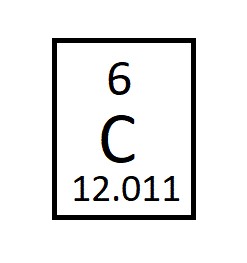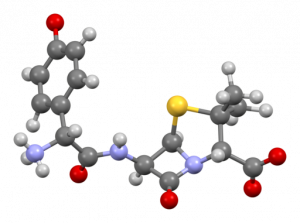1.2 Why Carbon?
 Carbon, atomic number 6, is an element with atoms that are small and relatively simple. The nucleus contains 6 positively-charged protons, and there are 6 electrons outside the nucleus distributed into two shells. The outer shell has four electrons that are held quite strongly by the electrostatic pull from the nucleus. So while a carbon atom can be ionized through either the gain or loss of electrons, it does not tend to do so. Carbon does however readily engage in covalent bonding, sharing electrons with neighboring atoms and forming tight associations with them. The four valence electrons in a carbon atom can do this by forming four single bonds, or by forming two single bonds and a double bond, by forming one single bonds and a triple bond, or by forming two double bonds.
Carbon, atomic number 6, is an element with atoms that are small and relatively simple. The nucleus contains 6 positively-charged protons, and there are 6 electrons outside the nucleus distributed into two shells. The outer shell has four electrons that are held quite strongly by the electrostatic pull from the nucleus. So while a carbon atom can be ionized through either the gain or loss of electrons, it does not tend to do so. Carbon does however readily engage in covalent bonding, sharing electrons with neighboring atoms and forming tight associations with them. The four valence electrons in a carbon atom can do this by forming four single bonds, or by forming two single bonds and a double bond, by forming one single bonds and a triple bond, or by forming two double bonds.
Carbons covalently bond with one another, also, forming chains of various lengths, and rings. It readily bonds with other atoms such as oxygen, nitrogen and hydrogen, forming quite stable arrangements with these common elements as well.

The architecture of carbon structures is therefore fantastically varied. Small organic molecules might contain just one or two carbon atoms surrounded by other atoms. But the larger organic molecules can contain hundreds or thousands of carbons, linked with rings and bridges and other complex structures that fold into particular three-dimensional structures.
Carbon is a bit like a basic Lego building block. The 6-pin Lego is able to make lots of other connections, and also can make strong, stable connections. It has the features that make it an ideal basic building block for the construction of a wide variety of larger, complex shapes necessary for biological function. In a similar fashion Carbon can make 4 bonds, with varying geometry and generally stable structures.

No other element can quite do what carbon does: Silicon has the ability to form four bonds with other atoms but those bonds tend to be weak due to the additional electron shell in a silicon atom. Nitrogen has five valence electrons so generally only forms 3 single bonds, limiting its usefulness. Boron, similarly, does not make for a dependable, stable base structure.
Exercises 1.2.1-4

